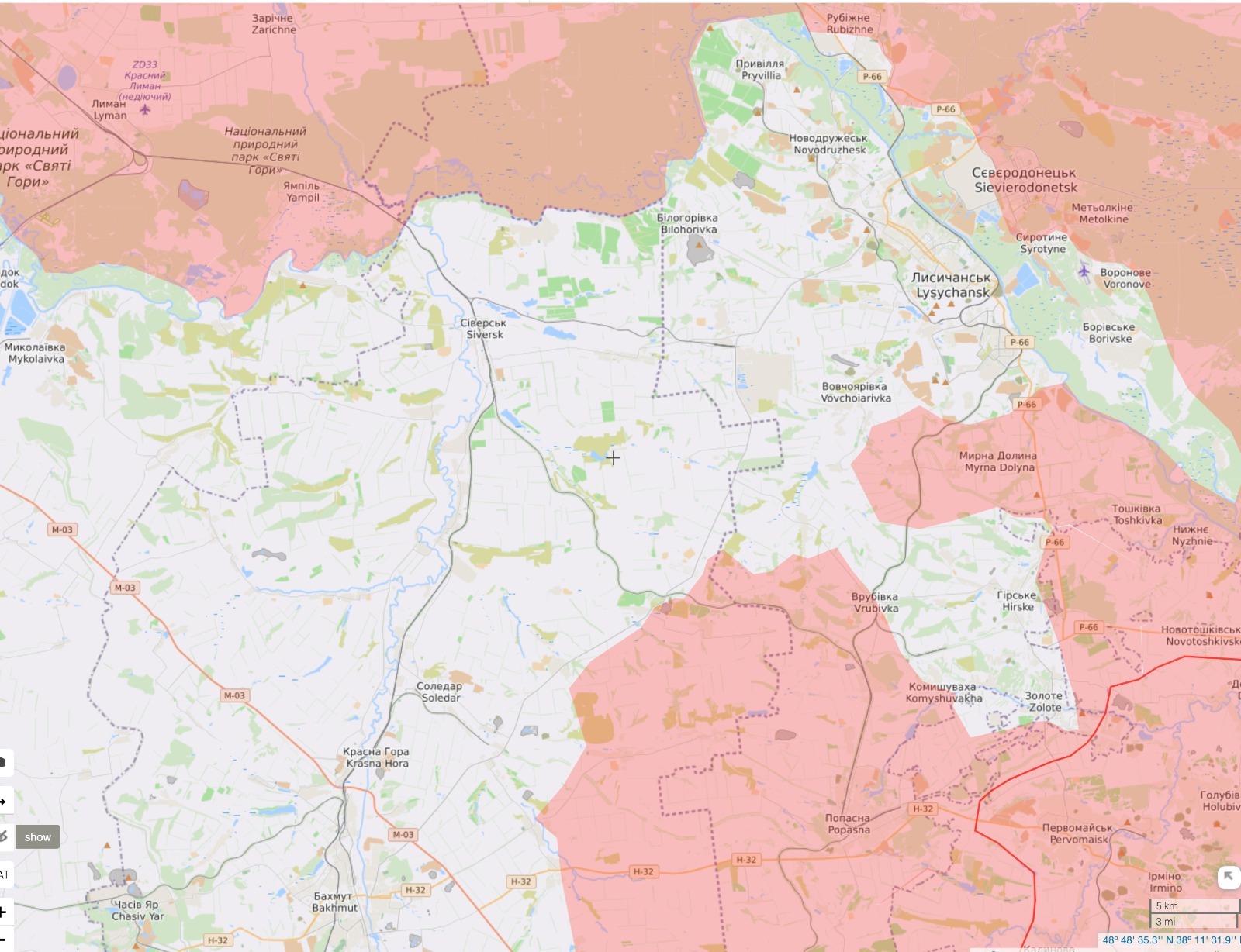(MENAFN- Asia Times) Summary/overview
The Ukrainian General Staff (UGS) has ordered the withdrawal of forces from Severodonetsk.

Russian forces south of Lysychansk have closed the corridor (“salient within the [Donbas] salient”) from Myrna Dolyna south through Hirske to Zolote [see map 1 and comparison map 2 of 48 hours earlier] and, according to the Russian Ministry of Defense, have trapped some 2000 Ukrainian troops (four battalions and an artillery unit) and foreign fighters. The closure of the salient but not the number of troops encircled has been confirmed by the UGS.

Russian forces are pressing north out of Toshkivka into the southern approaches to Lysychansk and are swinging west and north to cut off Severodonetsk's twin city entirely. Ukrainian Luhansk Oblast head Sergyi Haidai said on Telegram that the Ukrainian forces might soon retreat from Lysychansk since their defensive positions had been destroyed and there is“little sense” in staying.
Ukrainian sources report that Russia has moved an S-300 air defense unit into just-occupied Severodonetsk. The S-300 would be layered with shorter-range systems (Pantsir), provide air denial and make the use of long-range artillery by the Ukrainians more difficult and less accurate.
Russian air defenses have been beefed up across the board and have begun to effectively attrit Ukrainian drones. The Ukrainians are currently flying only 20 to 30 sorties per day. Russians sorties number 300 per day – of all types.
The ability to successfully deny airspace to drones will be of significance as it will severely limit the effectiveness of long-range artillery systems such as HIMARS.
According to US sources, the first HIMARS multiple rocket launch systems (all four promised?) have been delivered to Ukraine.
Belarus is conducting maneuvers and mobilization exercises in southeastern Belarus, directly north of Kiev. This appears to be designed to tie down some Ukrainian forces, but Belarus President Lukashenko is unlikely to be prodded into attacking Ukraine. The exercises will wrap up on July 1.
Center/east
In addition to activities in the Severodonetsk/Lysychansk area, Russian forces are continuing to press north from the area of Popasna and have the entire main road from Bakhmut to Lysychansk under fairly constant artillery fire.
On the north side of the Donbas salient Russian forces continue to position toward and slowly advance under heavy artillery cover to attack Slovyansk. But there was no substantive ground force activity in that area.
There were no substantive movements by either Russian or Ukrainian forces north and northeast of Kharkiv. But intermittent Russian artillery and rocket fire on suburbs of Kharkiv continues.
South
Russian forces continue to strengthen their defensive positions and are moving more forces and gear into the Kherson area. There was no significant ground activity.
Assessment
There is an argument put forward by some credible analysts that the Russian victory at Severodonetsk is a Pyrrhic victory, that they have spent so much time and so many troops and ordnance that it cannot be considered a decisive victory.
The argument overlooks several points.
First, the implied historical reference makes no sense. Pyrrhus of Epirus in his victorious but debilitating engagements with the Romans was the demographically and economically weaker party. The victorious Russians are the equivalent of the Romans, superior in manpower and economic reserves.
Second, while the Russians in the battle for Severodonetsk certainly incurred significant losses, there is no doubt by any objective observer that the slow-grind, heavily artillery-supported Russian advance led to much heavier losses – of manpower, in particular – on the Ukrainian side.
Indeed, military analyst Colonel Reisner of the Austrian Military Academy argues, the Russian slow-grind strategy was precisely designed to inflict maximum destruction of Ukrainian military assets:“The Russians have in effect operationally encircled [eingekessel] the Donbas salient. They can open and close the entrance to the cauldron at will. They have not closed it because the Ukrainians continually are sending in soldiers and weapons, which the Russian can then destroy. They've got the Ukrainians where they want them, in a cauldron.”
Third, as any reader of Clausewitz will of, course, note, a victory is a victory and a loss is a loss and it tells on morale. Says an American observer:“The Russians and Ukrainians stood toe-to-toe and the Russians came out ahead.”
Lastly, in a war of attrition, the type of war that the Russian have forced upon the Ukrainians and that the Ukrainians have accepted to fight, the country with four times the population and ten times the economic power will win.
By their own count, the Ukrainians have taken large losses. By their own count, the Ukrainians, to speak of only one weapons system, need one hundred Himars or 270mm MRLS units, not 8 or 10 or 12.
They cannot trade numbers over the long run. A war that lasts more than the next few months will require that they make some effort to keep their more experienced soldiers. At an operational level, they need to consider collapsing the Donbas salient and withdrawing to a defensive line farther west that they can hold.
Strategically, Zelensky needs a better plan.
MENAFN24062022000159011032ID1104429464
Legal Disclaimer:
MENAFN provides the information “as is” without warranty of any kind. We do not accept any responsibility or liability for the accuracy, content, images, videos, licenses, completeness, legality, or reliability of the information contained in this article. If you have any complaints or copyright issues related to this article, kindly contact the provider above.